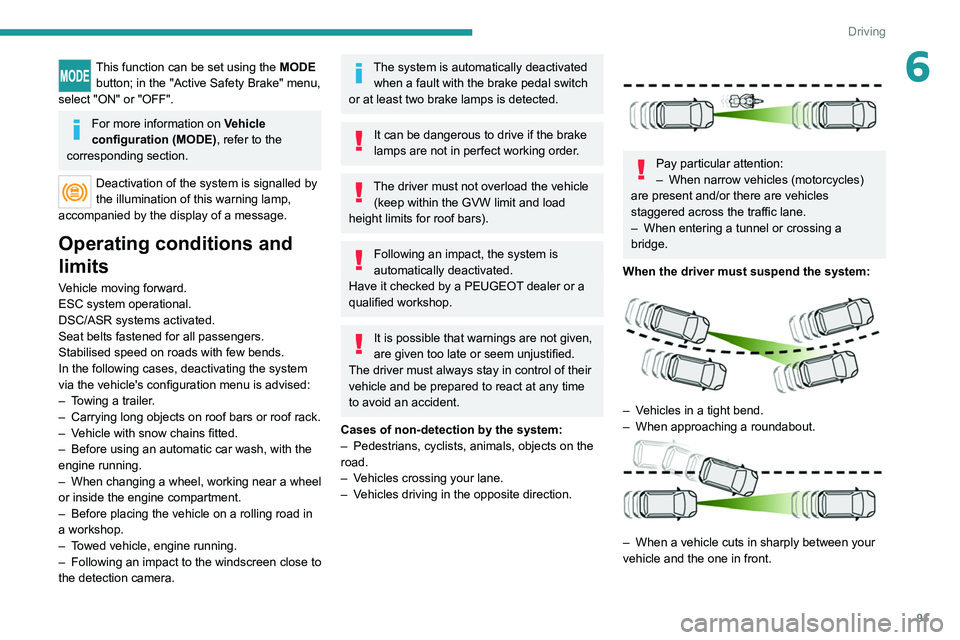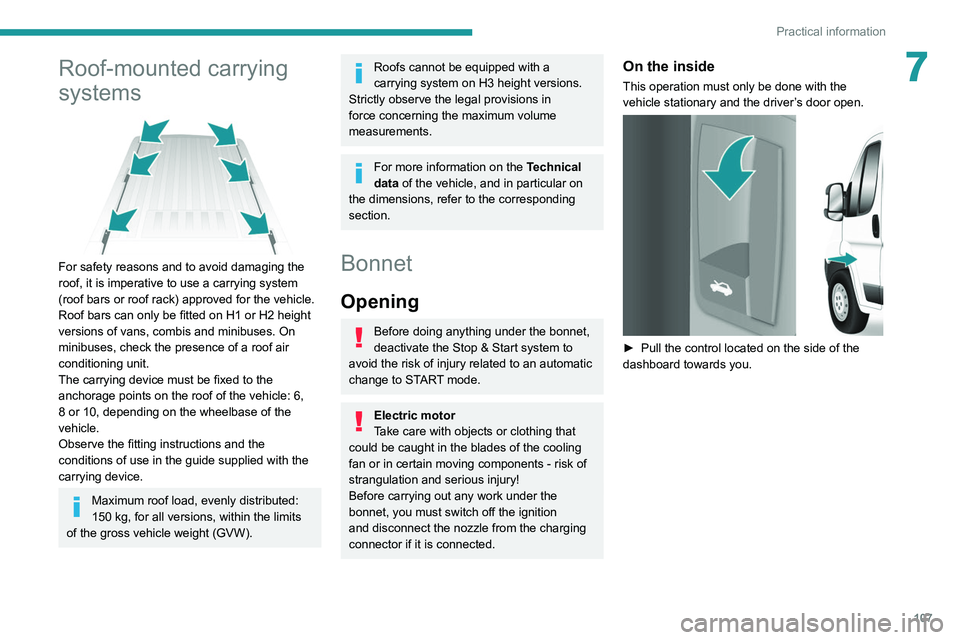Page 93 of 212

91
Driving
6This function can be set using the MODE button; in the "Active Safety Brake" menu,
select "ON" or "OFF".
For more information on Vehicle
configuration (MODE) , refer to the
corresponding section.
Deactivation of the system is signalled by
the illumination of this warning lamp,
accompanied by the display of a message.
Operating conditions and
limits
Vehicle moving forward.
ESC system operational.
DSC/ASR systems activated.
Seat belts fastened for all passengers.
Stabilised speed on roads with few bends.
In the following cases, deactivating the system
via the vehicle's configuration menu is advised:
–
T
owing a trailer.
–
Carrying long objects on roof bars or roof rack.
–
V
ehicle with snow chains fitted.
–
Before using an automatic car wash, with the
engine running.
–
When changing
a wheel, working near a wheel
or inside the engine compartment.
–
Before placing the vehicle on a rolling road in
a workshop.
–
T
owed vehicle, engine running.
–
Following
an impact to the windscreen close to
the detection camera.
The system is automatically deactivated when a fault with the brake pedal switch
or at least two brake lamps is detected.
It can be dangerous to drive if the brake
lamps are not in perfect working order.
The driver must not overload the vehicle (keep within the GVW limit and load
height limits for roof bars).
Following an impact, the system is
automatically deactivated.
Have it checked by a PEUGEOT dealer or a
qualified workshop.
It is possible that warnings are not given,
are given too late or seem unjustified.
The driver must always stay in control of their
vehicle and be prepared to react at any time
to avoid an accident.
Cases of non-detection by the system:
–
Pedestrians, cyclists, animals, objects on the
road.
–
V
ehicles crossing your lane.
–
V
ehicles driving in the opposite direction.
Pay particular attention:
– When narrow vehicles (motorcycles)
are present and/or there are vehicles
staggered across the traffic lane.
–
When entering a tunnel or crossing a
bridge.
When the driver must suspend the system:
– Vehicles in a tight bend.
– When approaching a roundabout.
– When a vehicle cuts in sharply between your
vehicle and the one in front.
Page 109 of 212

107
Practical information
7Roof-mounted carrying
systems
For safety reasons and to avoid damaging the
roof, it is imperative to use a carrying system
(roof bars or roof rack) approved for the vehicle.
Roof bars can only be fitted on H1 or H2 height
versions of vans, combis and minibuses. On
minibuses, check the presence of a roof air
conditioning unit.
The carrying device must be fixed to the
anchorage points on the roof of the vehicle: 6,
8 or 10, depending on the wheelbase of the
vehicle.
Observe the fitting instructions and the
conditions of use in the guide supplied with the
carrying device.
Maximum roof load, evenly distributed:
150 kg, for all versions, within the limits
of the gross vehicle weight (GVW).
Roofs cannot be equipped with a
carrying system on H3 height versions.
Strictly observe the legal provisions in
force concerning the maximum volume
measurements.
For more information on the Technical
data of the vehicle, and in particular on
the dimensions, refer to the corresponding
section.
Bonnet
Opening
Before doing anything under the bonnet,
deactivate the Stop & Start system to
avoid the risk of injury related to an automatic
change to START mode.
Electric motor
Take care with objects or clothing that
could be caught in the blades of the cooling
fan or in certain moving components - risk of
strangulation and serious injury!
Before carrying out any work under the
bonnet, you must switch off the ignition
and
disconnect the nozzle from the charging
connector
if it is connected.
On the inside
This operation must only be done with the
vehicle stationary and the driver’s door open.
► Pull the control located on the side of the
dashboard towards you.
Page 143 of 212
141
Technical data
9Dimensions
Dimension values are given in millimetres.
Va n
Your vehicle comes in 4 lengths (L1, etc.) and 3 heights (H1, etc.):
L1 L2L3L4
H1 H2 H1 H2 H2 H3 H2 H3
L Overall length 4,9635,4135,9986,363
H Overall height 2,254 2,524 2,254 2,524 2,524 2,764 2,524 2,764
A Wheelbase 3,0003,450 4,035
Page 144 of 212
142
Technical data
L1L2L3L4
H1 H2 H1 H2 H2 H3 H2 H3
B Front overhang 948
C Rear overhang 1,0151,380
D Width (with/without mirrors) 2,508/2,050
E Front track width 1,810
F Rear track
width 1,790
G Loading sill height 535 to 565
I Interior floor length 2,6703,1203,7054,070
J Maximum interior load height 1,662 1,932 1,662 1,932 1,932 2,172 1,932 2,172
K Maximum interior width 1,870
M Interior width between wheel arches 1,422
Volume (m
3) 8 9.510 11.5 13 15 15 17
Page 145 of 212
143
Technical data
9Rear doors
L1L2L3L4
H1 H2 H1 H2 H2 H3 H2 H3
N Rear doors useable height 1,520 1,790 1,520 1,790 1,790 2,030 1,790 2,030
O Rear doors useable width 1,562
Side door
Page 146 of 212
144
Technical data
L1L2L3L4
H1 H2 H1 H2 H2 H3 H2 H3
P Height of the sliding side door 1,485 1,755 1,485 1,755 1,755
Q Width of the sliding side door 1,0751,250
Combi
L1H1 L2H2
A 751 8721,201 1,322
B 1,201 1,7431,6512,193
C -860 -860
Page 153 of 212
151
Special features
10L1L2L2S L3L4
A Wheelbase 3,000 3,450 3,800 4,035 4,035
B Front overhang 948
C Rear overhang 9601,325
D Width (with/without mirrors) 2,508/2,050
- Buildable width 2,207
- Maximum buildable width 2,350
E Front track width 1,810
- Rear track
width 1,790
- Increased rear track width 1,980
F Overall height 2,254
- Maximum buildable height 3,500
Page 155 of 212
153
Special features
10L1L2L2SL3L4
A Wheelbase 3,000 3,450 3,800 4,035 4,035
B Front overhang 948
C Rear overhang 1,3451,710
D Width (with/without mirrors) -/2,100
- Buildable width -
- Maximum buildable width -
E Front track width 1,810
- Rear track
width 1,790
- Increased rear track
width 1,980
F Overall height 2,153
- Maximum buildable height -